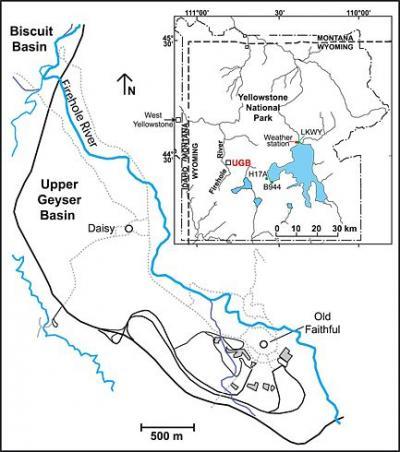The intervals between geyser eruptions depend on a delicate balance of underground factors, such as heat and water supply, and interactions with surrounding geysers. Some geysers are highly predictable, with intervals between eruptions (IBEs) varying only slightly. The predictability of these geysers offer earth scientists a unique opportunity to investigate what may influence their eruptive activity, and to apply that information to rare and unpredictable types of eruptions, such as those from volcanoes.
Dr. Shaul Hurwitz took advantage of a decade of eruption data—spanning from 2001 to 2011—for two of Yellowstone's most predictable geysers, the cone geyser Old Faithful and the pool geyser, Daisy.
Dr. Hurwitz's team focused their statistical analysis on possible correlations between the geysers' IBEs and external forces such as weather, earth tides and earthquakes. The authors found no link between weather and Old Faithful's IBEs, but they did find that Daisy's IBEs correlated with cold temperatures and high winds. In addition, Daisy's IBEs were significantly shortened following the 7.9 magnitude earthquake that hit Alaska in 2002.

This is a map showing the location of Daisy and Old Faithful geysers in Yellowstone's Upper Geyser Basin. Inset map of Yellowstone National Park shows the weather station at Yellowstone Lake, seismic stations LKWY and H17A, and strainmeter B944.
(Photo Credit: Images taken from: Shaul Hurwitz, Robert A. Sohn, Karen Luttrell, Michael Manga, "Triggering and modulation of geyser eruptions in Yellowstone National Park by earthquakes, earth tides, and weather", Journal of Geophysical Research: Solid Earth, DOI:10.1002/2013JB010803)
The authors note that atmospheric processes exert a relatively small but statistically significant influence on pool geysers' IBEs by modulating heat transfer rates from the pool to the atmosphere. Overall, internal processes and interactions with surrounding geysers dominate IBEs' variability, especially in cone geysers.
Source: Wiley